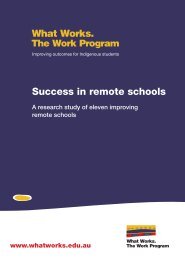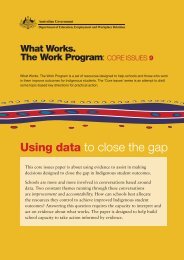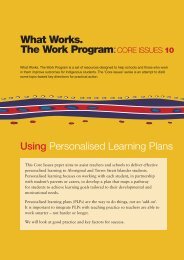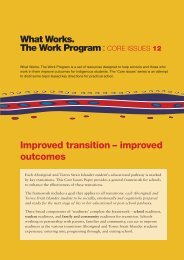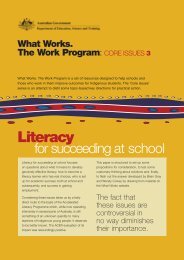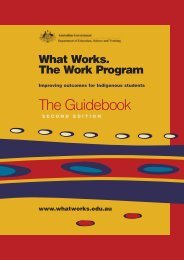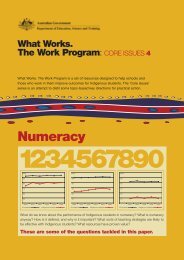Bound for Success Scope and Sequence Statements
Bound for Success Scope and Sequence Statements
Bound for Success Scope and Sequence Statements
- No tags were found...
Create successful ePaper yourself
Turn your PDF publications into a flip-book with our unique Google optimized e-Paper software.
TECHNOLOGYIn<strong>for</strong>mationMany <strong>for</strong>ms of media are designed by people <strong>for</strong> particular social <strong>and</strong> commercial purposes. Each is designed using the same technology processes that are used to create all products of technology.ConceptIn Year 1the student:In Year 2the student:In Year 3the student:In Year 4the student:In Year 5the student:In Year 6the student:In Year 7the student:In Year 8the student:In Year 9the student:In<strong>for</strong>mation…knows aboutmethods, techniques<strong>and</strong> purposes ofin<strong>for</strong>mation.• Explores <strong>and</strong> describesways in which in<strong>for</strong>mationis passed on (e.g. aninvitation to a party tellspeople when <strong>and</strong> where itis; the news on TV tellspeople what is happeningin the world).• Explores <strong>and</strong> compareshow in<strong>for</strong>mation can bepresented <strong>and</strong> used indifferent ways <strong>and</strong> <strong>for</strong>different audiences (e.g.compares different <strong>for</strong>msof advertising <strong>for</strong> the sameproduct <strong>and</strong> says “the flyerisn’t as good as the posterbecause it is hard to read<strong>and</strong> doesn’t have brightcolours”).• Investigates techniquespeople use to makeadvertising interesting <strong>for</strong>different audiences.• Explores <strong>and</strong> describesrelated <strong>for</strong>ms of media <strong>and</strong>how they are used bydifferent people, (e.g.examines newspapers, TVnews <strong>and</strong> radio news asways of spreading thenews about a specifictopic). N• Knows that in<strong>for</strong>mationcan be stored <strong>and</strong>transmitted in differentways within thecommunity (e.g. sounds<strong>and</strong> pictures can be storedon CDs in a st<strong>and</strong>ard<strong>for</strong>mat <strong>for</strong> sharing;in<strong>for</strong>mation on foodpackets indicate what is inthe packet; labels on seedpackets displayin<strong>for</strong>mation about seeds<strong>and</strong> how to plant them).• Knows <strong>and</strong> describes theways in<strong>for</strong>mation is used,created <strong>and</strong> presented indifferent ways <strong>for</strong>particular audiences (e.g.says “I have used a posterinstead of a brochurebecause it is larger <strong>and</strong>more people can see itfrom a distance”).• Describes the advantages<strong>and</strong> disadvantages ofdifferent <strong>for</strong>ms ofin<strong>for</strong>mation (e.g. says“Billboards are designedto be large so that theycan easily be seen whiledriving but they maydistract drivers causingaccidents”).• Identifies differentfeatures of in<strong>for</strong>mationproducts that suggest thetarget audiences <strong>and</strong>purposes of eachin<strong>for</strong>mation product (e.g.examines the language <strong>and</strong>genre to decide the agegroup that a narrative ispitched at; examines theway graphs <strong>and</strong> tables areincluded in reports <strong>and</strong>pictures of people areselected <strong>and</strong> used inadvertising).• Knows that there aredifferent <strong>for</strong>ms, st<strong>and</strong>ards<strong>and</strong> conventions used inparticular in<strong>for</strong>mationproducts <strong>and</strong> processes(e.g. knows that labelsshowing type <strong>and</strong> quantityof ingredients are requiredon food packaging, <strong>and</strong>examines various junkmail comparing size ofphotos <strong>and</strong> aspects ofphotography). N• Knows that the use ofin<strong>for</strong>mation has changedover time <strong>and</strong> that newtechnologies haveincreased the impact onusers, the speed ofdissemination ofin<strong>for</strong>mation (e.g.compares radioadvertising with TVadvertising <strong>and</strong> the humansenses that are influencedin marketing; compares a1940’s newscast with ablog to consider howin<strong>for</strong>mation impacts on<strong>and</strong> changes society).• Knows that variousmethods <strong>and</strong> strategies inadvertising are used toinfluence buyers (e.g.identifies the use of aloud, fast voice inadvertising furniture orcars <strong>and</strong> knows that thiscreates a sense of urgency,or identifies the use ofcolour on food packaging<strong>for</strong> children).• Knows that control <strong>and</strong>dissemination ofin<strong>for</strong>mation can be used toinfluence society (e.g. useof propag<strong>and</strong>a to influencevoters; targeting fast foodadvertisements at youngchildren).…uses methods,techniques <strong>and</strong>purposes ofin<strong>for</strong>mation.• Uses in<strong>for</strong>mationtechnologies tocommunicate simplemessages (e.g. designs aparty invitationconsidering importantdesign factors such as fontsize).• Designs simplein<strong>for</strong>mation products witha particular audience inmind (e.g. an in<strong>for</strong>mationbrochure <strong>for</strong> parents onhealthy eating, or a poster<strong>for</strong> others in the school).• Creates classroom displayson current classroomtopics (e.g. make a posterto promote healthy eating).• Uses simple techniques toaccess, record <strong>and</strong> presentin<strong>for</strong>mation (e.g. operatesa DVD player or iPOD,<strong>and</strong> presents thein<strong>for</strong>mation gathered in adifferent <strong>for</strong>m using wordsor pictures).• Creates simple advertisingproducts using existingadvertising as a model(e.g. makes a poster toadvertise a public displayof their insect-catchingdevices). N• Designs <strong>and</strong> generates arange of in<strong>for</strong>mationproducts <strong>for</strong> real life <strong>and</strong>life-like purposes (e.g.prepares a two-pageadvertising brochure tomarket their desktoporganiser to other classes).M• Designs <strong>and</strong> generatesseveral related in<strong>for</strong>mationproducts <strong>for</strong> a specificevent (e.g. designs posters,business cards <strong>and</strong>brochures to highlight thelocal festival). N• Trans<strong>for</strong>ms in<strong>for</strong>mationfrom one <strong>for</strong>m to another<strong>for</strong> a different purpose oraudience <strong>and</strong> recogniseswhen this has been done(e.g. re-writes a brochurereducing its complexity<strong>for</strong> a younger audience, ordevelops a web pagetutorial using a technicalmanual as their source;creates a brochureincorporating tables <strong>and</strong>graphs). N• Designs their ownadvertising material orproduct label such as a CDlabel or food-productlabel, using st<strong>and</strong>ards <strong>and</strong>conventions. N• Selects <strong>and</strong> usesprocedures, conventions<strong>and</strong> language to create arange of in<strong>for</strong>mationproducts (e.g. develops astep-by-step set ofinstructions to set a videotimer or program an MP3player; develops a criteriasheet to be used to awardmarks <strong>for</strong> their ownassessment; developsadvertising materials <strong>for</strong>an election campaign). N• Manipulates, trans<strong>for</strong>ms<strong>and</strong> creates in<strong>for</strong>mation toachieve particular effects(e.g. uses colour <strong>and</strong>design when serving foodin order to make it lookmore appetising <strong>and</strong>describes how <strong>and</strong> whythey have done this, ordesigns a brochure onrecycling, promoting thehealth benefits rather thanjust the technical aspects).N• Analyses issues related tocopyright of packagingideas <strong>and</strong> control ofin<strong>for</strong>mation related to foodst<strong>and</strong>ards (e.g. nutritionpanel labellingrequirements according toFSANZ) to identifyrequirements on thepackaging <strong>for</strong> an ‘eatinggreen’ product they havedeveloped.<strong>Bound</strong> <strong>for</strong> <strong>Success</strong> <strong>Scope</strong> <strong>and</strong> <strong>Sequence</strong> <strong>Statements</strong> V2 Page 84 Working Document Semester One 2007



